
The North Atlantic Treaty Organization, also called the North Atlantic Alliance, is an intergovernmental military alliance of 32 member states—30 European and 2 North American. Established in the aftermath of World War II, the organization implements the North Atlantic Treaty, signed in Washington, D.C., on 4 April 1949. NATO is a collective security system: its independent member states agree to defend each other against attacks by third parties. During the Cold War, NATO operated as a check on the threat posed by the Soviet Union. The alliance remained in place after the dissolution of the Soviet Union and the Warsaw Pact, and has been involved in military operations in the Balkans, the Middle East, South Asia and Africa. The organization's motto is animus in consulendo liber. The organization's strategic concepts include deterrence.
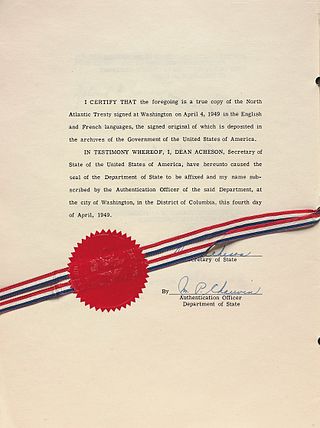
The North Atlantic Treaty is the treaty that forms the legal basis of, and is implemented by, the North Atlantic Treaty Organization (NATO). The treaty was signed in Washington, D.C., on 4 April 1949.

The Shanghai Cooperation Organisation (SCO) is a Eurasian political, economic, international security and defence organization established by China and Russia in 2001. It is the world's largest regional organization in terms of geographic scope and population, covering approximately 80% of the area of Eurasia and 40% of the world population. As of 2021, its combined GDP was around 20% of global GDP.

The Partnership for Peace is a North Atlantic Treaty Organization (NATO) program aimed at creating trust and cooperation between the member states of NATO and other states mostly in Europe, including post-Soviet states; 18 states are members. The program contains 6 areas of cooperation, which aims to build relationships with partners through military-to-military cooperation on training, exercises, disaster planning and response, science and environmental issues, professionalization, policy planning, and relations with civilian government. During policy negotiations in the 1990s, a primary controversy regarding PfP was its ability to be interpreted as a program that is a stepping stone for joining NATO with full Article 5 guarantees.

The NATO Parliamentary Assembly serves as the consultative interparliamentary organisation for the North Atlantic Treaty Organization. Its current President is Michał Szczerba from Poland, elected in 2023. Its current Secretary General is Ruxandra Popa, who has been in this position since January 2020.

The 2006 Riga summit or the 19th NATO Summit was a NATO summit held in the Olympic Sports Centre, Riga, Latvia from 28 to 29 November 2006. The most important topics discussed were the War in Afghanistan and the future role and borders of the alliance. Further, the summit focused on the alliance's continued transformation, taking stock of what has been accomplished since the 2002 Prague Summit. NATO also committed itself to extending further membership invitations in the upcoming 2008 Bucharest Summit. This summit was the first NATO summit held on the territory of the Baltic states.

The 2004 Istanbul summit was held in Istanbul, Turkey from 28 to 29 June 2004. It was the 17th NATO summit in which NATO's Heads of State and Governments met to make formal decisions about security topics. In general, the summit is seen as a continuation of the transformation process that began in the 2002 Prague summit, which hoped to create a shift from a Cold War alliance against Soviet aggression to a 21st-century coalition against new and out-of-area security threats. The summit consisted of four meetings.

Georgia and the North Atlantic Treaty Organization (NATO) enjoy cordial relations. Georgia is not currently a member of NATO, but has been promised by NATO to be admitted in the future.
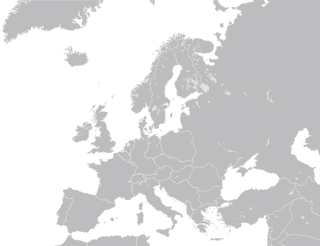
NATO is a military alliance of thirty-two European and North American countries that constitutes a system of collective defense. The process of joining the alliance is governed by Article 10 of the North Atlantic Treaty, which allows for the invitation of "other European States" only and by subsequent agreements. Countries wishing to join must meet certain requirements and complete a multi-step process involving political dialog and military integration. The accession process is overseen by the North Atlantic Council, NATO's governing body. NATO was formed in 1949 with twelve founding members and has added new members ten times. The first additions were Greece and Turkey in 1952. In May 1955, West Germany joined NATO, which was one of the conditions agreed to as part of the end of the country's occupation by France, the United Kingdom, and the United States, prompting the Soviet Union to form its own collective security alliance later that month. Following the end of the Franco regime, newly democratic Spain chose to join NATO in 1982.
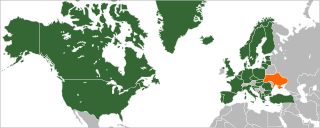
Relations between Ukraine and the North Atlantic Treaty Organization (NATO) started in 1991 following Ukraine's independence after the dissolution of the Soviet Union. Ukraine joined NATO's Partnership for Peace in 1994 and the NATO-Ukraine Commission in 1997, then agreed the NATO-Ukraine Action Plan in 2002 and entered into NATO's Intensified Dialogue program in 2005. Although Ukraine initially declared neutrality and non-alignment with military blocs after independence, it has sought NATO membership after it was attacked by Russia in 2014.
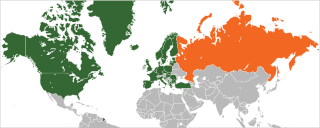
Relations between the NATO military alliance and the Russian Federation were established in 1991 within the framework of the North Atlantic Cooperation Council. In 1994, Russia joined the Partnership for Peace program, and on 27 May 1997, the NATO–Russia Founding Act (NRFA) was signed at the 1997 Paris NATO Summit in France, enabling the creation of the NATO–Russia Permanent Joint Council (NRPJC). Through the early part of 2010s NATO and Russia signed several additional agreements on cooperation. The NRPJC was replaced in 2002 by the NATO–Russia Council (NRC), which was established in an effort to partner on security issues and joint projects together.
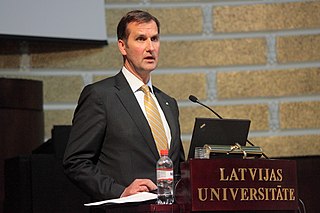
Māris Riekstiņš is a Latvian politician and diplomat and a former Foreign Minister of Latvia. He is the former Ambassador of Latvia to the Russian Federation. Currently serves as Permanent Representative of Latvia to NATO.
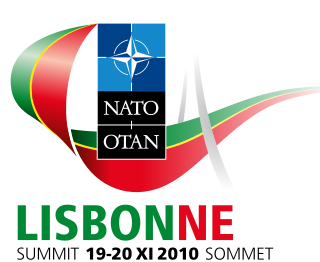
The 2010 Lisbon summit was a meeting of the heads of state and heads of government of NATO held in Lisbon, Portugal, on 19 and 20 November 2010.
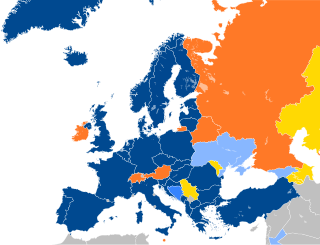
NATO maintains foreign relations with many non-member countries across the globe. NATO runs a number of programs which provide a framework for the partnerships between itself and these non-member nations, typically based on that country's location. These include the Euro-Atlantic Partnership Council and the Partnership for Peace.
The 1997 Madrid summit was a meeting of the heads of state and heads of government of the sixteen members of the North Atlantic Treaty Organization (NATO) and their partner countries held in Madrid, Spain, on 8–9 July 1997. It was the 15th NATO summit and the second in 1997, the previous one being held in Paris. The summit was notable for inviting three new members, Hungary, Poland, and the Czech Republic to join the alliance.

The relationship between Azerbaijan and NATO started in 1992 when Azerbaijan joined the newly created North Atlantic Cooperation Council. Considerable partnership between NATO and Azerbaijan dates back to 1994, when the latter joined Partnership for Peace program. Azerbaijan established a diplomatic Mission to NATO in 1997 by the Presidential Decree on 21 November.

The Lublin Triangle is a regional alliance of three European countries – Lithuania, Poland, and Ukraine – for the purposes of strengthening mutual military, cultural, economic and political cooperation and supporting Ukraine's integration into the European Union and NATO. The Lublin Triangle initiative invokes the integrative heritage of the 1569 Union of Lublin.

The Bucharest Nine or the Bucharest Format is an organization founded on 4 November 2015 in Bucharest, Romania, at the initiative of the President of Romania Klaus Iohannis and the President of Poland Andrzej Duda during a bilateral meeting between them. Its members are Bulgaria, the Czech Republic, Estonia, Hungary, Latvia, Lithuania, Poland, Romania and Slovakia. Its appearance was mainly a result of a perceived aggressive attitude from Russia following the annexation of Crimea from Ukraine and its posterior intervention in eastern Ukraine both in 2014. All members of the B9 were either part of the former Soviet Union (USSR) or members of the defunct Soviet-led Warsaw Pact.

The 2022 Madrid summit was a meeting of the heads of state and heads of government of the thirty members of the North Atlantic Treaty Organization (NATO), their partner countries, and the European Union, held in Madrid, Spain, on 29–30 June 2022. Spain previously hosted a NATO Summit in 1997.
In the context of the enlargement of NATO, Article 10 of the North Atlantic Treaty is the origin for the April 1999 statement of a "NATO open door policy". The open door policy requires a consensus in favour of countries applying to join NATO, as all member states must ratify the protocol enabling a new country to become a member of NATO. The open door policy "is aimed at promoting stability and cooperation".


















